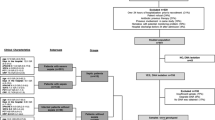Abstract
Identifying single nucleotide polymorphisms (SNPs) in the genes involved in sepsis may help to clarify the pathophysiology of neonatal sepsis. The aim of this study was to evaluate the relationships between different forms of bacterial infections in neonates and genes potentially involved in the response to invasion by infectious agents. The study involved 20 neonates with a diagnosis of sepsis, 25 neonates with localized bacterial infections, and otherwise healthy neonates born during the study period. A total of eight SNPs in four candidate genes including Toll-like receptors (TLR2, TLR4) and pro-inflammatory cytokines (IL-1, Il-6) were genotyped. Genotypes CT and TT of IL-1β C3953T were associated with a significantly increased risk of developing sepsis (OR = 9.3; p = 0.02). The percentage of heterozygotes for the mutant allele was 65 %, while homozygotes—5 %. Among the patients with localized bacterial infections, TLR4 Asp299Gly, genotypes CT and TT IL-1β C3953T, and genotypes GC and CC IL-1β G-1473C showed the association with an increased risk of developing diseases (p = 0.05, p = 0.04, p = 0,04, respectively). These results show that genetic variability seems to play a role in sepsis and localized bacterial infections in neonates by influencing susceptibility to the disease.
Similar content being viewed by others
References
Lawn, J. E., Cousens, S., Zupan, J. T. (2005). Lancet Neonatal Survival Steering. 4 million neonatal deaths: when? Where? Why? Lancet, 365(9462), 891–900.
Verma, P., Berwal, P. K., Nagaraj, N., et al. (2015). Neonatal sepsis: epidemiology, clinical spectrum, recent antimicrobial agents and their antibiotic susceptibility pattern. The International journal Contemporary pediatrics, 2(3), 176–180.
Luan, Y. Y., Dong, N., Xie, M., et al. (2014). The significance and regulatory mechanisms of innate immune cells in the development of sepsis. Journal of Interferon & Cytokine Research, 34, 2–15.
Schulte, W., Bernhagen, J., Bucala, R. (2013). Cytokines in sepsis: potent immunoregulators and potential therapeutic targets—an updated view. Mediators of Inflammation, 2013, 165974.
Hansen, J. D., Vojtech, L. N., Laing, K. J. (2011). Sensing disease and danger: a survey of vertebrate PRRs and their origins. Developmental and Comparative Immunology, 35(9), 886–897.
Tissieres, P., Ochoda, A., Dunn-Siegrist, I., et al. (2012). Innate immune deficiency of extremely premature neonates can be reversed by interferon-γ. PloS One, 7(3), e32863.
Forster-Waldi, E. K., Sadeghi, D., Tamandl, B., et al. (2005). Monocyte TLR4 expression and LPS-induced cytokine production increase during gestational aging. The Journal of pediatrics research, 58, 121–124.
Sadeghi, K., Berger, A., Langgartner, M., et al. (2007). Immaturity of infection control in preterm and term newborns is associated with impaired toll-like receptor signaling. Journal of Infectious Diseases, 195(2), 296–302.
Jabandziev, P., Smerek, M., Michalek, J., et al. (2014). Multiple gene-to-gene interactions in children with sepsis: a combination of five gene variants predicts outcome of life-threatening sepsis. Jabandziev et al. Critical Care, 18, R1.
Ahrens, P., Kattner, E., Kohler, B., et al. (2004). Mutation of genes involved in the innate immune system as predictors of sepsis in very low birth weight infants. Journal of pediatrics research, 55, 652–656.
Esposito, S., Zampiero, A., Pugni, L., et al. (2014). Genetic polymorphisms and sepsis in premature neonates. Plos One, 9(7), e101248.
Picard, C., von Bernuth, H., Ghandil, P., et al. (2010). Clinical features and outcome of patients with IRAK-4 and MyD88 deficiency. Medicine (Baltimore), 89(6), 403–425.
Cuenca, A. G., Wynn, J. L., Moldawer, L. L., et al. (2013 February). Role of innate immunity in neonatal infection. American Journal of Perinatology, 30(2), 105–112.
Faber, J., Meyer, C. U., Gemmer, C., et al. (2006). Human toll-like receptors 4 mutations are associated with susceptipility to invasive meningococcal disease in infancy. Journal of pediatric infection, 25(1), 80–81.
Kurt, A. N., Aygun, A. D., Gogekmerdan, A., et al. (2007). Serum IL-1beta, IL-6, IL-8 and TNF-alpha levels in early diagnosis and management of neonatal sepsis. Mediators of Inflammation, 2007, 31397.
Santana Reyes, C., Garcia-Munoz, F., Reyes, D., et al. (2003). Role of cytokines (interleukin-1beta, 6, 8, tumor necrosis factor-alpha and soluble receptor of interleukin-2) and C-reactive protein in the diagnosis of neonatal sepsis. Acta pediátrica, 92, 221–227.
Abu-Maziad, Schaa, K., Bell, E. F., et al. (2010). Role of polymorphic variants as genetic modulators of infection in neonatal sepsis. Pediatric Research, 68(4), 323–329.
Read, R. C., Cannings, C., Naylor, S. C., et al. (2003). Variation within genes encoding intrleukin-1 and the interleukin-1 receptor antagonist influence the severity of meningococcal disease. Annals of Internal Medicine, 138, 534–541.
Zhang, A., Pan, W., Gao, J., et al. (2014). Associations between interleukin-1 gene polymorphisms and sepsis risk: a meta-analysis. BMC Medical Genetics, 15, 8.
Acknowledgments
The work is performed according to the Russian Government Program of Competitive Growth of Kazan Federal University and subsidy allocated to Kazan Federal University for the state assignment in the sphere of scientific activities. Some of the experiments were conducted using the equipment of Interdisciplinary center for collective use of Kazan Federal University supported by Ministry of Education of Russia (ID RFMEFI59414X0003) and Pharmaceutical Research and Education Center, Kazan (Volga Region) Federal University, Kazan, Russia.
Author information
Authors and Affiliations
Corresponding author
Ethics declarations
Conflict of Interest
The authors declare that they have no conflict of interest.
Rights and permissions
About this article
Cite this article
Khaertynov, K.S., Anokhin, V.A., Rizvanov, A.A. et al. Genetic Polymorphisms and Bacterial Infections in Neonates. BioNanoSci. 7, 78–84 (2017). https://doi.org/10.1007/s12668-016-0298-6
Published:
Issue Date:
DOI: https://doi.org/10.1007/s12668-016-0298-6




